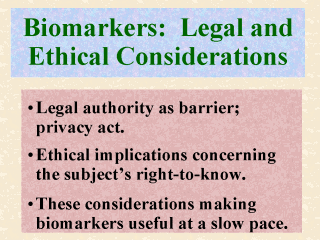| front |1 |2 |3 |4 |5 |6 |7 |8 |9 |10 |11 |12 |13 |14 |15 |16 |17 |18 |19 |20 |21 |22 |23 |review |
 |
Legal authority
to even passively monitoring human exposure is an additional concern or barrier in the use
of biomarkers. For instance, under the Privacy Act, an employee could refuse to
participate in most any worker monitoring program. For biomonitoring studies conducted
under good laboratory practices, informed consent forms must be well designed and
carefully executed. According to Ashford et al. (1990), the U.S. Supreme Court in
1989 ruled that certain exceptions such as for monitoring drinking and drug taking on the
job are outside worker privacy. The use of biomonitoring results can have ethical implications. When a biomarker test shows a positive result or a high level of exposure, the study investigator may be morally obligated to inform the test individual this unpleasant finding. If not, the test subjectís health may be in jeopardy or compromised. Yet the investigatorís first obligation is to use the study data in accord with the research intent. To alert subjects tested with high levels of exposure may require more than results from the study. The investigator might have to go beyond the normal course to ascertain the subjectís exposure activity, his or her personal habit, and health condition. Students are referred to the papers by Lappe (1986) and by Last (1994) for more generic ethical issues/principles (e.g., paternalism, beneficence, autonomy, nonmaleficence). These legal and ethnical conditions, along with the scientific and technical concerns discussed in the last two slides, are barriers to the use of biomarkers in human exposure assessment, which is central to health risk assessment. |